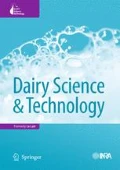This special issue is dedicated to the tenth anniversary of the Science and Technology of Milk and Eggs research unit (French acronym STLO), visit our website at https://www6.rennes.inra.fr/stlo_eng/. STLO is a joint research unit under administrative supervision of the National Institute for Agricultural Research (INRA) and the Institute for life, food and horticultural sciences and landscaping (AGROCAMPUS OUEST) located in Rennes, in the main milk production region of France. Nowadays, STLO gathers 77 research scientists, professors, engineers, and technicians, and 45 graduate students (Ph.D., Masters, and post-docs). It is the most important research team in dairy science and technology in France and is recognized for its expertise in food science on an international level. The objectives of STLO’s teams are to explore the mechanisms and issues involved in the transformation of milk and eggs using a multidisciplinary and multiscale approach, from the native molecules to their final functionality, including nutritional and biological properties.
In 2004, STLO started a new cycle of research with more mechanistic approaches and expectancy of original results to reinforce the continuum between fundamental knowledge, its technological transfer, and applications. This partnership was initiated by Dr Jean-Louis Maubois in the mid 1970s, when he developed dairy research in Rennes. He managed the laboratory for over 35 years and developed a special policy of regular exchanges with the industry. We are grateful to him and also to Dr. Sylvie Lortal who succeeded him in 2004 and strongly contributed to the international audience of the lab.
To celebrate this tenth anniversary, we offer the readers of the journal six review papers illustrating the advances in different—but non-exhaustive—STLO research topics. During these 10 years, research in dairy science has advanced significantly with omics methodologies and output technologies that allow a fine analysis of milk components and derivatives. This possibility has enhanced the investigation on the biological components in milk such as bioactive peptides. R. Boutrou et al. provide a survey on the bioactive peptides released in vivo in the digestive tract of adult human and animals. Concerning the control of functionality of milk proteins, one of our scientific challenges is to understand the behavior of whey protein aggregates in order to extend the application fields. In their review, F. Guyomarc’h et al. focus on the most recent advances in structure-function relationships of whey proteins in the native or denatured/aggregated forms. In the same line, C. Broyard and F. Gaucheron propose an interesting review on the modifications of caseins and casein micelles allowing to gain new functional properties. An important aspect of our research concerns the structuration of matrix in processed products, and this investigation strongly depends on the knowledge of the organization of lipids in milk. C. Lopez et al. outline the recent advances on the organization of the milk fat globule membrane and of lipids in various processed dairy products using advanced microscopy techniques such as confocal microscopy and atomic force microscopy. STLO has also a large expertise in food drying. With an approach based on the drying of a single droplet, C. Sadek et al. show how this model contributes to understand the fundamental aspects of the drying phenomena. After this travel through the engineering and biochemical aspects, some microbial aspects of ongoing research are also be presented. A. Thierry et al. illustrate how strain-to-strain differences for a given species, here lactic acid and propionic acid bacteria, can determine the final properties in the end product.
All these results arise from collaborative studies between STLO research scientists, amongst which many are active members of the editorial board of the journal. My best thanks for all these contributions.
Finally, we hope that you will value this special issue of Dairy Science & Technology.
Author information
Authors and Affiliations
Corresponding author
About this article
Cite this article
Léonil, J. Foreword. Dairy Sci. & Technol. 95, 769–770 (2015). https://doi.org/10.1007/s13594-015-0268-8
Published:
Issue Date:
DOI: https://doi.org/10.1007/s13594-015-0268-8

